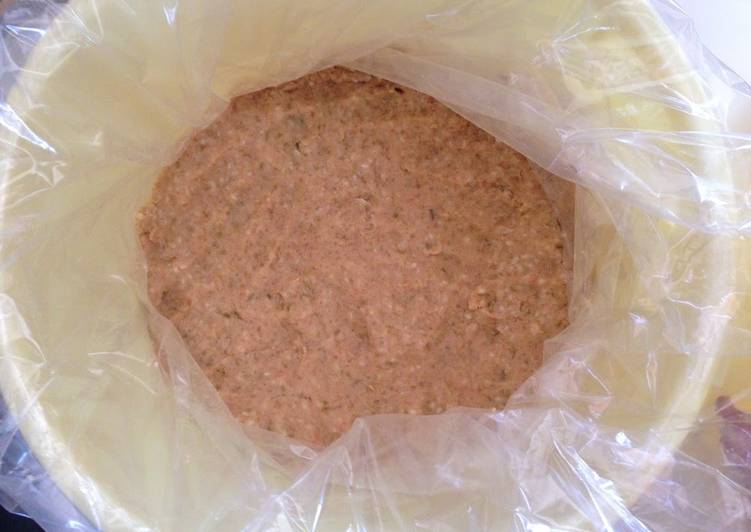
Hello everybody, I hope you are having an amazing day today. Today, we’re going to prepare a special dish, authentic homemade miso. It is one of my favorites food recipes. This time, I’m gonna make it a little bit tasty. This will be really delicious.
Making Homemade Miso Paste: What ingredients and tools you will need, with step by step instructions and resources for obtaining everything you will need. Yuri shows you how to make Japanese vegan Miso Soup. You can make this recipe entirely from vegetables and it tastes very good.
Authentic Homemade Miso is one of the most popular of current trending meals on earth. It is enjoyed by millions every day. It is simple, it’s fast, it tastes delicious. They are fine and they look wonderful. Authentic Homemade Miso is something that I have loved my entire life.
To begin with this recipe, we must prepare a few components. You can have authentic homemade miso using 4 ingredients and 19 steps. Here is how you can achieve that.
The ingredients needed to make Authentic Homemade Miso:
- Prepare 1 kg Soy beans
- Take 1 kg Koji (dried or fresh)
- Prepare 500 grams Salt
- Make ready 2 Red chili peppers (optional)
How to Make Authentic Miso Soup. Miso Katsudon is a delicious Donburi (rice bowl) dish made from katsu (fried pork/meat) on top of rice coated with a tasty Chopstick Chronicles. Authentic traditional & contemporary Japanese recipes. Miso paste is a funky, salty-sweet, umami-rich paste of mashed, koji-kin inoculated and fermented Yes, You Can Make Miso Paste at Home!
Instructions to make Authentic Homemade Miso:
- Rinse the soy beans, then soak them in plenty of water overnight (for a 24 hour period). The soy beans will triple in size from rehydrating, so be sure to use a large pot.
- Here is what they should look like after soaking. Depending on the soy bean, scum may appear, but without removing the scum, set the pot to boil (do not refresh the water).
- Bring to a boil over high heat, then reduce to the lowest setting. Skim the scum and simmer until the soy beans can be slightly crushed between your fingers (this should take anywhere from 3 to 8 hours).
- This is how it should look after skimming off the scum from the surface. Do not bother to remove it too carefully; just skim enough to remove the majority of it.
- Test by crushing a soy bean between your fingers, and if it can be slightly crushed, turn off the heat, cover with a lid, then let sit overnight.
- Return the pot to heat and simmer for about 30 minutes over low heat. They are now ready to be turned into miso.
- Prepare the necessary ingredients and equipment: 2 bowls or pots, a 10-liter pickling tub, 2 large food-grade plastic bags, and a potato masher.
- While simmering the soy beans, break up the koji into small pieces, then combine with the salt.
- Line the pickling tub with a double layer of the food-grade plastic bags.
- Mash the soy beans (to your desired consistency) with a potato masher while still hot . Do not discard the boiling water from the soy beans.
- This is what the soy beans look like after they are mashed (I mashed them to a miso-like consistency). For easy mashing, use a meat grinder, if available.
- Once the soy beans have cooled to the touch, mix in the koji. Then, mix in the boiling water from the soy beans until the consistency resembles miso paste.
- Pack the miso into patties, as though making hamburger patties, while pressing out any air pockets.
- Slam the miso patties into the tub as hard as you can, and after several handfuls, press out the air and level the surface, then repeat.
- Level the surface while pressing out the air, and very lightly sprinkle with salt.
- To the extent possible, press the excess air from the inner bag and tie it closed with string.
- Place a drop lid on top, then weigh the miso down with a weight equivalent to the weight of the beans. If you don't have a weight, use a bag of salt. The key is to press down on the miso with substantial weight.
- Press out any air, and secure the outer plastic bag with a string. If you have red chili peppers, place them inside the outer bag to inhibit mold growth. You could also use shichimi (7 season chili spice mix) spice.
- Cover the outside of the bucket to prevent dust from entering. Store it in a cool, unheated environment. Every 2 months, stir it up, and taste until it reaches the desired degree of fermentation.
Authentic product of Japan Contains separate miso and garnish packs Very similar to homemade/fresh miso soup you're served in a Japanese restaurant. Carefully read "How to Make Natto" in our website to make your own homemade natto using this starter. Miso and Health: Explanation from Abundant Nutrients of Miso to Its Expiration Date. Kimchi fried rice made with my own homemade kimchi! Made japchae in bulk using your recipe for a church's fundraiser! Отмена..
So that is going to wrap it up with this exceptional food authentic homemade miso recipe. Thank you very much for your time. I am confident that you can make this at home. There is gonna be interesting food in home recipes coming up. Don’t forget to bookmark this page on your browser, and share it to your loved ones, friends and colleague. Thanks again for reading. Go on get cooking!

